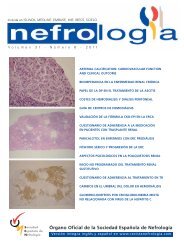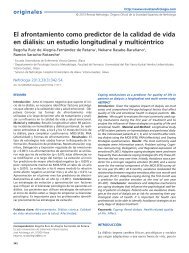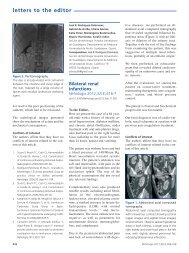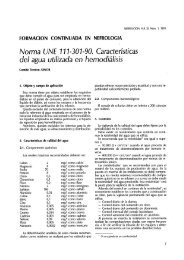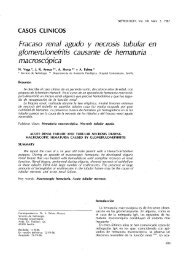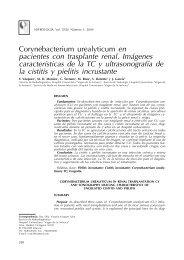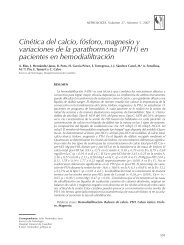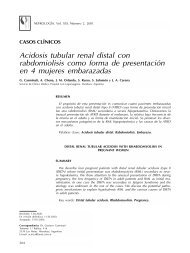PDF Número - NefrologÃa
PDF Número - NefrologÃa
PDF Número - NefrologÃa
You also want an ePaper? Increase the reach of your titles
YUMPU automatically turns print PDFs into web optimized ePapers that Google loves.
Supranee Kongkham et al. Alpha Tocopherol Prevent CIN in Rats<br />
originales<br />
useful for treatment in many nephropathy, such as cisplatininduced<br />
acute renal failure 32 or cadmium. 33 These components<br />
consist of renal toxicity with their pathogenic effects on oxidative<br />
stress. In the present study, the increased lipid peroxidation<br />
caused by the increased oxidative stress in the kidneys<br />
induced by radio-contrast media was assessed and<br />
investigated. It was found that the lipid peroxidation products,<br />
in terms of MDA, increased in both renal tissue and<br />
serum. A consistency in the decrease of serum TAC and renal<br />
SOD activity was observed in CIN-induced rats. These<br />
results are in agreement with the observation of many studies.<br />
26 SOD, an enzymatic antioxidant, can act to scavenge superoxide<br />
ions. This present study shows the significantly lower<br />
levels of SOD activity in CIN-induced rats, as compared<br />
with those of the control group. The decreased activity of<br />
SOD in renal tissue of CIN-induced rats may be the result of<br />
oxidative stress induced by inactivation and/or excessive antioxidant<br />
consumption, 34 and is a causative factor in oxidative<br />
damage. In the current study, vitamin E supplements, particularly<br />
in high doses, significantly attenuated the increase of<br />
MDA concentration in renal tissue and serum and significantly<br />
increased renal SOD activity. Nevertheless, the unaltered<br />
TAC level in renal tissues exposed to contrast media was observed,<br />
whereas the TAC level in the plasma of this group significantly<br />
decreased, when compared with the control group.<br />
From these findings, it was hypothesized that the compensatory<br />
mechanism of a tissue antioxidant state that develops in<br />
response to local oxidative stress by recycling of endogenous<br />
non-enzymatic antioxidant vitamins may have involved<br />
and/or associated a lesser sensitivity in the estimation of total<br />
antioxidant capacity value in tissue samples. 35,36 However, the<br />
antioxidant property of vitamin E is not only to scavenge<br />
ROS, but also to up-regulate antioxidant enzymes through<br />
regulation of the gene expression or activity of antioxidant<br />
enzymes. 37-39 In this study, the supplements of vitamin E exhibited<br />
the elevated renal SOD activity which indicates an elevated<br />
antioxidant status. These data were similar to a number<br />
of reports which have shown that the increased activity<br />
of intracellular antioxidant enzymes can also be correlated<br />
with a decrease in lipid peroxidation increases. 40,41<br />
Nefrologia 2013;33(1):116-23<br />
Taken together, the evidence presented in this study has<br />
shown that imbalance in antioxidative scavenger-promoted<br />
generation of MDA, resulting in appearance of renal tubular<br />
injury, is consistent with histological assessment. This study<br />
showed that outer medullary congestion of renal cells, one of<br />
the vascular hallmarks of CIN, 42 was significantly higher in<br />
the CIN-induced rats. After vitamin E supplementation, we<br />
found that medullary congestion significantly decreased, in<br />
comparison with the CM group. Furthermore, high incidence<br />
of tubular necrosis in the CM group was presented, whereas<br />
a low score of tubular necrosis in both of the CM groups administrated<br />
with vitamin E was found. These results support<br />
the fact that vitamin E treatment has a preventive effect in the<br />
improvement of histopathological changes, and that these observations<br />
have paralleled the decrease in MDA levels and increase<br />
in SOD activity. Moreover, all of the oxidative stress<br />
marker concentrations found in this experiment are likewise<br />
related to the pathogenesis of CIN and its pathologic markers,<br />
including BUN and serum creatinine. The increase in<br />
BUN and serum creatinine have been found in CIN-induced<br />
rats, but not in CIN-induced rats supplemented with vitamin<br />
E. It implied that vitamin E treatment can reduce the renal<br />
dysfunction caused by radio-contrast media.<br />
In this study, an effective dose of vitamin E also has been<br />
investigated at dosages of 250 and 500mg/kg/day. It was<br />
found that a low dose cannot reduce the MDA level, but a<br />
higher dose can reduce, in particular, the serum MDA and<br />
the renal MDA; increase the renal SOD activity; and attenuate<br />
renal dysfunction. In present results, supplementation<br />
with vitamin E 250mg/kg/day exhibited the increasing<br />
MDA and SOD activity in renal tissue were demonstrated<br />
when compared to control group. In our opinions, it is possible<br />
to assume that low dose of vitamin E can have pro-oxidant<br />
effects on renal tissue and accompany an inappropriate<br />
dose to generate antioxidant effect. It has been reported<br />
that vitamin E acts as a pro-oxidant by activation of enzymatic<br />
antioxidant (SOD and GPx), leading to increase lipid<br />
peroxidation 43 and also its capacity of free radical scavenger<br />
is a dose dependent manner. 39 The high dosages of vitamin<br />
E found to be effectively protective of the renal function<br />
from oxidative damage in rat models have been demonstrated<br />
in several studies. 44 Results of the present study imply<br />
that high doses of vitamin E provide a beneficial effect<br />
against CIN. However, the high dosage used in this study<br />
(approximately equivalent to human doses at 2500mg in an<br />
adult of 60kg body weight) was found to be higher than that<br />
of a tolerable upper intake level (UL) of vitamin E<br />
(1000mg/day), as recommended by the food and Nutrition<br />
Board of the U.S. Institute of Medicine. Non-toxic intake of<br />
vitamin E in the highest dosage of 3200mg/day also has<br />
been shown. 45 Therefore, in further study, the short-term administration<br />
of an adjusted dosage of vitamin E (1000mg/d)<br />
prior to radio-contrast procedures in high-risk patients<br />
should be considered. Indeed, in CKD patients, several clinical<br />
studies have reported that the imbalance of oxidative<br />
stress and anti-oxidant levels are a common feature of CKD.<br />
Factors contributing to increased oxidative stress in CKD<br />
patients, such as diabetes, chronic inflammation and uremia,<br />
have also been reported. 46,47 For example, the uremic patients<br />
had higher levels of plasma oxidative markers and decreased<br />
antioxidant activities, as correlated with their levels<br />
of renal dysfunction. 48,49 Thus, as a means of preventing<br />
CIN, these patient groups should have the benefit of pretreatment<br />
with antioxidant vitamin E in cases of radio-contrast<br />
administration.<br />
In conclusion, the present study has emphasized the protective<br />
role of vitamin-E supplementation, which improves the<br />
renal dysfunction and morphological tubular injury in rats<br />
caused by CIN induction through its antioxidant activity.<br />
121



